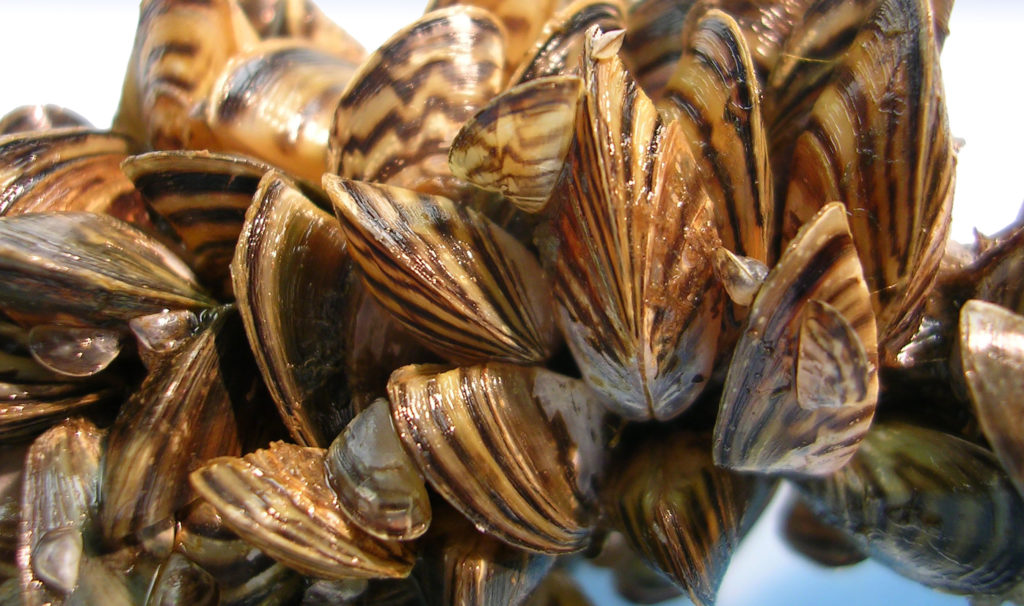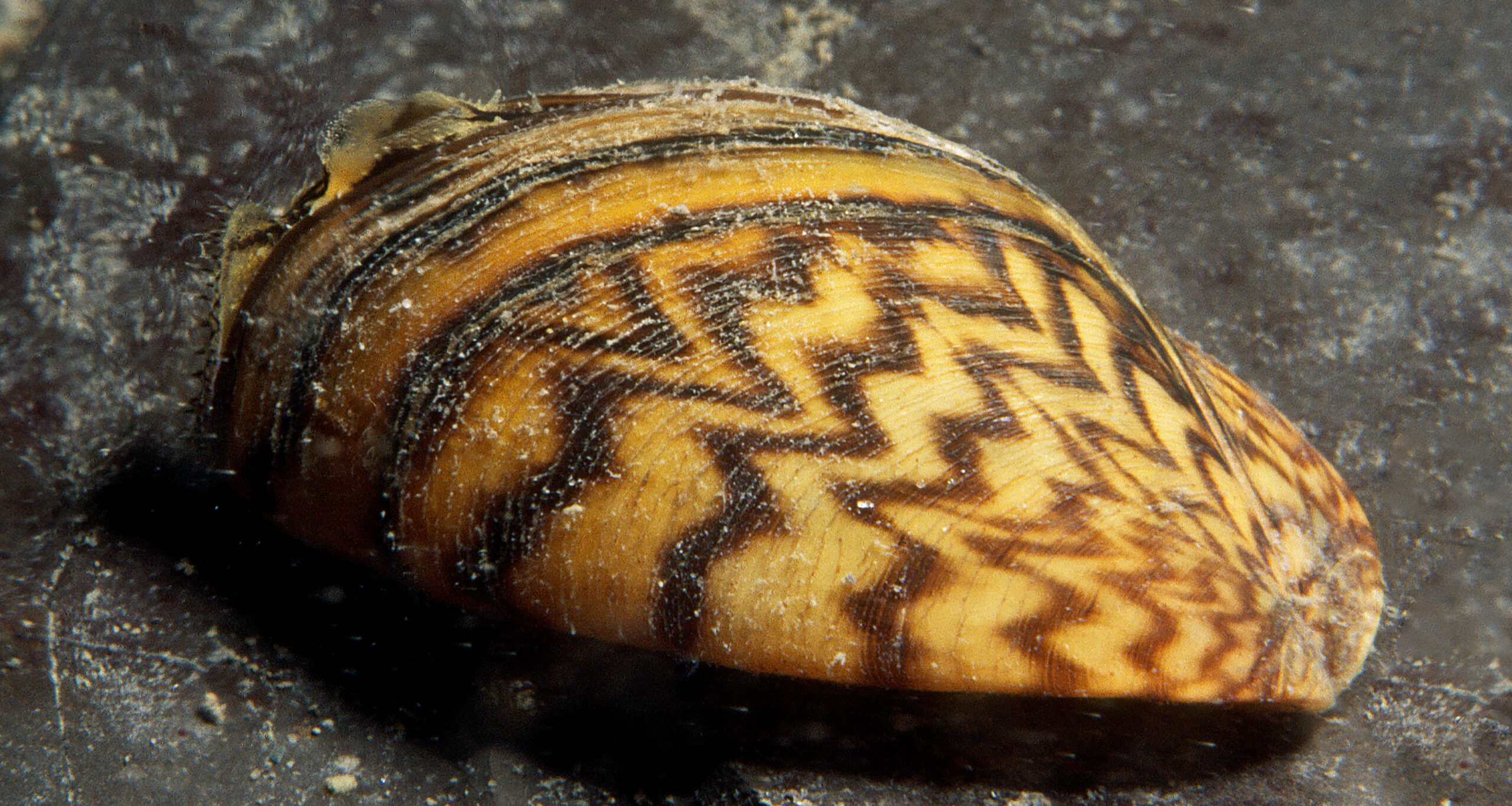Aquatic Invasive Species
What are aquatic invasive species?
Invasive species are organisms from another environment that are not native and harm the ecosystem. Invasive species pose a major problem in many ecosystems worldwide, causing significant ecological and economic damage by out-competing native species and reproducing out of control. When invaders disrupt the delicate balance of life, it threatens and can even drive native plants and animals to extinction.
Aquatic invasive species infesting waterways and infrastructure
Many aquatic invasive species threaten the natural environments of North America, and some even pose threats to critical infrastructure. These troublesome trespassers include zebra mussels, quagga mussels, Asian clams, New Zealand mud snails, and bryozoans. These species have spread rapidly throughout the continent, causing significant environmental harm, and requiring economic expense to manage or eradicate.
Zebra mussels (Dreissena polymorpha), quagga mussels (Dreissena bugensis), and Asian clams (Corbicula fluminea) are freshwater mollusks native to Europe and Asia. Invasive dreissenid mussels were first discovered in North America in the Great Lakes in the late 1980s and have since contaminated many waterways in the United States and Canada (EPA, 2023). These mussels are small, usually less than an inch long, but they reproduce prolifically and infest waterways by attaching themselves to water-related equipment. Zebra and quagga mussel infestations can shut down recreational waters and have damaged so much infrastructure that they are now considered among North America’s top 10 most damaging aquatic invasive species. Their veliger larvae are microscopic, float in water, and spread rapidly because females can release up to 1 million eggs per season (Benson, Raikow, Larson, et al., 2023). Adult mussels form dense clusters, frequently at concentrations exceeding 100,000 per square meter, that clog water intake pipes and damage boats, water intakes, and other structures.
In the environment, they displace native species or physically smother them. They also out-compete native fish, zooplankton, and other species for food resources, fundamentally altering the ecosystem. In the five years following discovery of zebra mussels in the Great Lakes, 12 species of native mollusk were completely wiped out (Nalepa et al., 1996). Read more about the dangers of zebra mussels here.
New Zealand mud snails (Potamopyrgus antipodarum) are another invasive species that has caused significant ecological damage in North America. These tiny snails, native to New Zealand, were first discovered in the United States in the 1980s and have since spread to many rivers and freshwater bodies in the western and northern US. Although they only grow 4-6 mm long, mud snails reach extremely high population densities and can deplete natural resources and drive out native life. New Zealand mud snails are challenging to control, as they are highly adaptable and can survive in a wide range of water conditions. Mud snails are so hardy that they can seal themselves off from the environment, be eaten, pass through a fish’s gut, and emerge unharmed.


The environmental impact of invasive species
The environmental impact of invasive species is significant. Invasive species lack natural predators or other means to curb their growth, allowing them to run rampant and devastate the balance of the ecosystem. New Zealand mud snails and zebra and quagga mussels are all filter feeders, meaning they consume substantial amounts of plankton and other microscopic organisms. This can cause a decline in populations of native species that rely on plankton for food, including fish and other aquatic animals. This over-competition drives out native species and can even lead to species extinction (National Wildlife Federation, 2023). Zebra and quagga mussels also release waste products in large quantities that transfer essential nutrients from the water column to the benthic zone (lake bottom), promote the growth of weeds, and can alter the chemistry of the water. This impact can lead to harmful algal blooms and other adverse effects.
New Zealand mud snails also disrupt native ecosystems by consuming massive quantities of vegetative food, resources, and native planktonic organisms. Like zebra and quagga mussels, these snails are particularly problematic because they reproduce rapidly and can reach incredibly high population densities.
When invasive species are left unchecked, they displace native species, disrupt the food web, decrease biodiversity, and devastate natural habitats.
The economic costs of invasive species
When invasive species overrun a new environment, it hurts the ecosystem and results in costly economic expenses. Bryozoans clog water intake pipes, potentially causing water shortages and equipment failure. Zebra and quagga mussels can cause damage to boats, docks, and other water infrastructure, leading to costly repairs and maintenance. In the Great Lakes region, Zebra mussels are estimated to cause $300–$500 million annually in damage to power plants, water systems, and industrial water intakes (Warziniack, 2023). Similarly, Asian clams have cost millions in damage to critical infrastructure used in power plant industries (Benson, Foster, Fuller, et al., 2023). In the USA, C. fluminea has caused millions of dollars of damage to intake pipes used in the power and water industries. Large numbers, either dead or alive, clog water intake pipes and the cost of removing them is estimated at about a billion US dollars annually (Anon., 2005). These figures do not include the expenses of preventing and controlling invasive species, which can also be exorbitant and ongoing. After the damage is done and mollusks perish, their shells may wash up on shorelines in countless numbers, littering recreational water areas and making them inhospitable for people and native species alike.
How to stop invasive species in their tracks
Prevention is crucial in controlling the spread of aquatic invasive species. Boaters and other recreational users of waterways can prevent “hitchhiking” by cleaning and drying boats and equipment. In cases where prevention is no longer possible, there are strategies for controlling and sometimes eradicating invasive aquatic species. These efforts are ongoing with varied methods and results.
Although prevention is preferable, control of invasive species can sometimes prove possible by various methods such as introducing natural predators, physical removal via manual labor, chemical rapid-response treatments, or water draining. Many of these methods require extensive time or costly resources and may produce imperfect results.
With innovation and research, other solutions can arise. A growing body of evidence suggests that reducing, controlling, and even eradicating invasive species within contained environments is sometimes possible. Some lakes have eliminated invasive species using low-dose ionic copper treatments like EarthTec QZ. EarthTec QZ’s unique formulation provides superior ion concentration under varying water conditions, resulting in a more cost-effective solution with greater efficacy at lower dose rates. EarthTec QZ is EPA-registered and certified NSF/ANSI/CAN 60 as a drinking water additive.
Although these dangerous aquatic invaders persist, continued research, resilience, and expert treatment solutions can help preserve our lakes, reservoirs, and natural waterways for years.
References
Anon. (2005). Corbicula fluminea (mollusk). Global Invasive Species Database. http://www.invasivespecies.net/database/species/ecology.asp?si=537&fr=1&sts=.
Benson, A., Foster, A.M., Fuller, P., Constant, S., Raikow, D., Larson, J., Fusaro, A., & A. Bartos. (2023). Corbicula fluminea. US Geological Survey, Nonindigenous Aquatic Species Database. https://nas.er.usgs.gov/queries/factsheet.aspx?speciesid=92
Benson, A.J., Raikow, D., Larson, J., Fusaro, A., Bogdanoff, A.K., & Elgin, A. (2023). Dreissena polymorpha. US Geological Survey, Nonindigenous Aquatic Species Database, https://nas.er.usgs.gov/queries/FactSheet.aspx?SpeciesID=5,
Nalepa, T.F., D.J. Hartson, G.W. Gostenik, D.L. Fanslow, and G.A. Lang. (1996). Changes in the freshwater mussel community of Lake St. Clair: from Unionidae to Dreissena polymorpha in eight years. Journal of Great Lakes Research 22(2):354–369. National Wildlife Federation. (2023). Invasive species. NWF. https://www.nwf.org/Educational-Resources/Wildlife-Guide/Threats-to-Wildlife/Invasive-Species#section-1
Raymond, N. (2023). What is biofouling and how can we stop it? Sofar Ocean. https://www.sofarocean.com/posts/what-is-biofouling-and-how-can-we-stop-it#:~:text=Biofouling%2C%20or%20biological%20fouling%2C%20is,of%20biofouling%3A%20microfouling%20and%20macrofouling
United States Environmental Protection Agency. (2022). Invasive Species in the Great Lakes. EPA. https://www.epa.gov/greatlakes/invasive-species-great-lakes-0
Warziniack, T., Haight, R. G., Yemshanov, D., Apriesnig, J. L., Holmes, T. P., Countryman, A. M., Rothlisberger, J. D., & Haberland, C. (2021). Economics of invasive species. Invasive Species in Forests and Rangelands of the United States, pp. 305–320. https://doi.org/10.1007/978-3-030-45367-1_14
